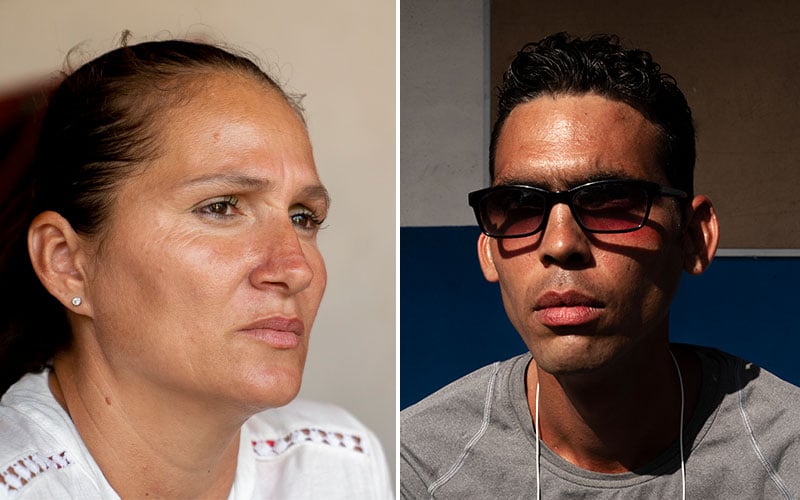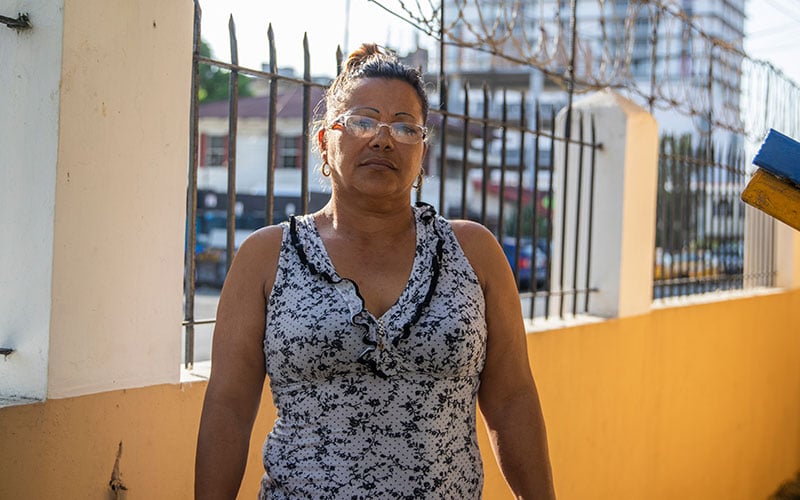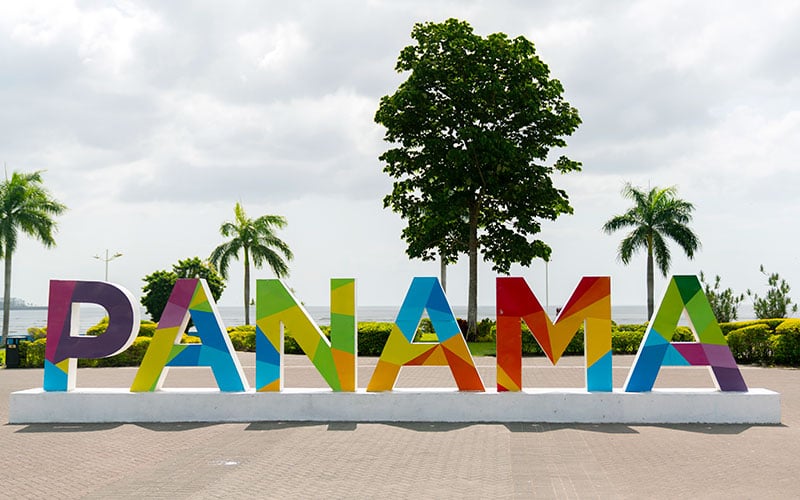
Marcelys Jiménez and Yordany Castillo Leyva traveled from Cuba with their sons, Angel Castillo Jiménez and Anyelo Castillo Jiménez. They eventually made it to the Fe y Alegría shelter in Las Mañanitas, Panamá. (Photo by Marcus Xavier Chormicle/Cronkite Borderlands Project)
PANAMA CITY, Panama – For Yordany Castillo Leyva, the decision to leave Cuba was a question of life and death.
As a former forensic medical examiner, Castillo had seen his share of dead bodies. Two years into his job at a Havana hospital, he said he noticed something strange about some of the victims brought to his autopsy table.
Authorities told him a 15-year-old girl and a 21-year-old man had died in a car accident. But he said he found marks consistent with strangulation and blows to the abdomen. A few weeks later, he had another body with the same story.
“I realized that they wanted to use me and make me an accomplice to murder,” he said. “I never accepted that condition at any moment.”
After sounding an alarm, Castillo said he lost his job, couldn’t find work and received threats from the police.
“My life became chaos,” he said. In October 2018, he decided to flee.
Castillo and his family are part of an exodus of Cubans disillusioned by the island’s communist revolution of 1959, which promised equality and economic security but left a complicated legacy of unfulfilled promises, a crumbling economy and a divisive dictatorship.
A series of immigration policy changes by the U.S. and Central American countries has created roadblocks forcing Cuban migrants to change their exodus routes. No longer can they expect automatic asylum if they reach the coast of Florida in makeshift rafts. Increasingly, Cuban migrants travel through Panama, hoping to reach the U.S. While some reach the U.S.-Mexico border, others give up and stay in countries that were not their original destinations.
“(Cubans enter from) Guyana, they enter from Ecuador, they enter from Brazil, and continue on the route, and want to continue crossing borders,” said Hussein Pitty, director of the Oficina Nacional para la Atención de Refugiados, Panama’s national office for refugees.”And what happened some years back? Guatemala and Nicaragua created barriers. Cubans were stuck in Panama and Costa Rica because of those obstacles.”
For some Cuban migrants, Panama has become a haven where they seek political freedom and economic stability. For others, it remains a rest stop.
Panama’s National Migration Service reports that of the 106,622 Cubans who entered Panama in 2019, it had no exit records for 9,124 of them, which indicates they have either overstayed their visas or continued to travel north without documents. The figure is about 10 times greater than the previous year.

Left: Marcelys Jiménez worked as a veterinarian before she left Cuba with her husband and two young sons. (Photo by Marcus Xavier Chormicle/Cronkite Borderlands Project) Right: Yordany Castillo Leyva worked as a forensic medical examiner in Cuba before fleeing with his family. (Photo by Marcus Xavier Chormicle/Cronkite Borderlands Project)
Castillo embarked on the journey with his wife, Marcelys Jiménez, and their two sons, Angel and Anyelo, ages 11 and 5. They flew to Guyana, a South American country with no visa requirements for Cubans. From there, they moved to Peru, where they lived for a year. The family left Peru after authorities denied their application for refugee status. They made their way north.
The family’s trip culminated in a trek across the Darién Gap, a 60-mile stretch of jungle that forms a natural border between Colombia and Panama. Castillo said they were assaulted three times and robbed of everything they had, forced to eat worms to survive.
By Jiménez’s count, the family watched 27 people die during their 11-day journey. One of them was an infant named Marcos, who drowned in the river, Castillo recalled, choking on the name.
“Day and night we walked, listening to the screams of different people who were left behind because they couldn’t go any longer,” Jiménez said.
The events they experienced are common among migrants who cross the Darién Gap, said Carlos Ayala, a psychologist at the nonprofit organization Fe y Alegría in Panama City. Migrants report seeing countless bodies and being raped, robbed or assaulted in the jungle.
“They pass through a series of physically demanding situations,” Ayala said. “They don’t all make it here.”
The Castillo family joined a group of about 150 people led through the jungle by local “coyotes” who charged them $50 each day. But by day three, Anyelo, their younger son, became ill, and the family had to fend for themselves.
They had packed enough food and medicine for eight days, but armed bandits robbed them three times, Jiménez said.
“When we reached a certain point, there were already people there waiting for us,” she said. “These people have no scruples about anything.”
On their last day in the jungle, having gone six days without eating, Jiménez could go no farther. She and the children stayed, and she sent Castillo out to look for help.
“Our strength had run out,” Jiménez said.
Castillo encountered a native Panamanian with a boat near Bajo Chiquito, one of the first entry points for migrants emerging from the jungle.
From Bajo Chiquito, migrants make their way to a migrant camp at La Peñita manned by Panama’s U.S.-trained border patrol agency, SENAFRONT. The country has developed a system known as “controlled flow” to monitor migrants and move them along to the next country to the north, Costa Rica.
At migrant camps in Panama, SENAFRONT officials take fingerprints of the migrants along with other biometrics and check them against international databases.
After addressing basic medical needs, they load migrants onto buses in La Peñita to transport them to other camps in northern Panama, and ultimately across the Costa Rican border. The governments of both countries facilitate the transportation.
Though they were pulled into the controlled flow system, Castillo and Jiménez decided they wanted to stay and build a life in Panama. Under Panamanian law, migrants are allowed to apply for asylum and other types of legal status.
Despite making their intentions known, Jiménez said SENAFRONT officials withheld their passports and forced them to board buses to two more camps.
Jiménez said authorities gave the family their passports and released them after they complained and began to video record their interactions with Panamanian officials.
“They told us we could leave on our own, but we were out of the migratory flow,” Jiménez said. “What happened to us was our responsibility.”
They arrived in Panama City on Dec. 31, 2019, joining thousands of migrants trying to make a living in the country.

Left: Carlos Ayala, a psychologist who works with migrants at nonprofit Fe y Alegría, says migrants must endure physically demanding situations. (Photo by Marcus Xavier Chormicle/Cronkite Borderlands Project) Right: The Fe y Alegría shelter in Panama provides assistance to a growing number of migrants seeking refuge. (Photo by Marcus Xavier Chormicle/Cronkite Borderlands Project)
Panama faces the effects of a chain of immigration policies that has shut migrants out of other countries.
Beginning in 2014, former President Barack Obama and Cuba’s then-President Raúl Castro announced they would restore full diplomatic ties between the two countries, after a long history of conflict.
During this process, the U.S. agreed to review its “Wet Foot, Dry Foot” policy, which granted asylum to Cubans who reached U.S. soil and allowed them to apply for residency after a year. Under the policy, those intercepted at sea were returned to Cuba.
When the policy was established in 1995, a deluge of Cubans poured into the seas on makeshift rafts, trying to make the 90-mile journey from Havana to Florida – hoping to avoid capture at sea and make it to dry land. Castillo, then a little boy, said he was one of them. But no more than 3 miles into the journey, the raft flipped over, and his mother decided to turn back.
Between 2014 and the end of 2016, the number of Cuban migrants presenting themselves at the U.S.-Mexico border after making the journey by land more than tripled.
They often flew to South American countries with lax visa requirements – such as Ecuador – and in the Castillo family’s case, Guyana, before traveling the remaining thousands of miles by land.
In November 2015, Nicaragua closed its borders to Cubans. In December 2015, Ecuador began requiring visas from Cubans to enter the country. Costa Rica and Panama both airlifted thousands of Cubans to Mexico in 2016 to continue their journeys to the United States, before following Nicaragua’s lead and closing their borders. In August of that year, Colombia began deporting thousands of Cubans.
On Jan. 12, 2017, just three days before leaving office, Obama terminated the two-decade old “Wet Foot, Dry Foot” policy.
In 2019, Cubans made up the second-largest group of immigrants coming into Panama through the Darién Gap, only behind Haitians, according to Panama’s National Migration Service.
Now, Cubans who make it to the U.S. – Mexico border are told by U.S. officials to wait in Mexico while their asylum requests are reviewed and processed.

Caridad Laffita Garcia has always known she wanted to leave Cuba. When her time came, she flew to Nicaragua and traveled over land to Panama. She currently works as a maid in Panama. (Photo by Daja Henry/Cronkite Borderlands Project)
“As a young woman, I always had the desire to leave. But when you have the desire, you still have to wait for the right conditions and everything you need to be able to leave,” said Caridad Laffita, a Cuban immigrant living in Hogar Luisa, a shelter run by the Catholic church in Panama.
Eight months before she arrived, her husband, Pascual Michel, had taken advantage of a $20 tourism visa specifically for self-employed Cubans traveling to Panama. By the time the couple had enough money for Caridad to join him, the Panamanian government abolished the visa.
Without the option of joining her husband via a tourist card, she flew to Nicaragua, which had loosened restrictions on Cuban travelers. Although she and Michel ultimately hope to travel north to the U.S., she instead went south to reunite with him.
The two sought refuge at the Hogar Luisa shelter in Panama City where they’re saving their money and waiting for the right conditions to continue to the United States.
This is common among Cuban migrants in the country, according to Raúl Elias Araúz de León, national director of Fe y Alegría, which provides assistance to migrants and educational opportunities to the poor.
“Cubans are a very unstable migrant population,” he said. Many arrive, apply for refugee status, stay for days or months, and continue to the U.S.
“The vast majority of Cubans who have come through the Darién never wanted to stay in Panama,” said Pitty, Panama’s refugee agency director. “They came to the office, did an application and left (the country).”
The office is working on a backlog of 16,000 applications for refugee status. When he took office, the 28-year-old said some applicants had waited three to five years for decisions.
In his first seven months in office, Pitty said he’s received more than 20,000 applications. Stacks of applications piled feet high cover a table in his office.

The Fe y Alegría shelter in Las Mañanitas assists migrants with rent for two months, but after that it is uncertain where migrants will live. (Photo by Marcus Xavier Chormicle/Cronkite Borderlands Project)
It is a growing challenge for the small country whose population of 4.3 million is just 300,000 more than the state of Oklahoma, as migrants from around the world land on its doorstep with nowhere else to go.
Pitty attributes the inundation of refugee applications to the country’s economic promise. According to the World Bank, Panama has been one of the fastest-growing economies in the world over the past decade.
Migrants see Panama as a relatively stable country, with an active economy that uses the U.S. dollar, he said.
While the World Bank reported that the poverty rate has dropped to 12.5%, it noted that the rates were much higher in rural and indigenous communities. Moreover, it said recent the coronavirus pandemic could wipe out any gains on improving the poverty rate.
While the Castillo family’s refugee application is pending indefinitely, they do not have permission to work.
“Here in Panama, I thought I would have a better future for my children, because Panama promises a future for any citizen of any country, but I don’t know why they won’t give us the documents to work, to live life like an ordinary, decent human being,” Castillo said.
Fe y Alegría helped them find a place to stay. The group assists migrants with rent for two months, but after that it is uncertain where migrants will live.
Even if they were granted work permits, the former forensic medical examiner and his wife, a former veterinarian, still could not practice their professions in Panama since they are among 56 job classifications restricted to Panamanian citizens.
“How are we supposed to be able to take care of our children?” Jiménez asked.
Still, the family is grateful to have left Cuba.
“I’d prefer to die free than at the hands of a dictatorship,” Castillo said. “Panama is a free country, and one where you can develop as a person.”
Cronkite Borderlands Project is a multimedia reporting program in which students cover human rights, immigration and border issues in the U.S. and abroad in both English and Spanish.
